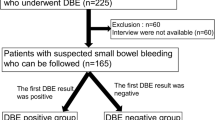Abstract
Background
Colonoscopy fails to achieve cecal intubation in 5–10 % of cases. Many of these cases can be completed using balloon-assisted colonoscopy, either with the single-balloon colonoscopy (SBC) or the double-balloon colonoscopy (DBC) techniques.
Aim
To compare the completion rates of SBC and DBC in patients with previous incomplete conventional colonoscopy.
Methods
Between August 2009 and July 2011 either SBC or DBC was performed in 53 patients in whom previous conventional colonoscopy did not achieve cecal intubation. The medical records of these 53 patients were reviewed retrospectively for details regarding (1) indication for the initial colonoscopy, (2) patient characteristics, (3) data from the initial colonoscopy, and (4) details on both SBC and DBC.
Results
SBC was successful in intubating the cecum in 100 % (26/26) of patients and DBC was successful in 93 % (25/27) of patients. The median (range) time to reach the cecum was 17 (9–43) min in the SBC group and 20 (7–58) min in the DBC group (P = 0.37). The presence of polyps was an entirely new finding in 35 % (9/26) of patients in the SBC group and 30 % (8/27) of patients in DBC group. Therapeutics were performed in 73 % (19/26) of patients in SBC group and 67 % (18/27) of patients in DBC group.
Conclusion
For patients with incomplete conventional colonoscopy, SBC and DBC offer high cecal intubation rates as well as detection of additional polyps and therapeutic capability. Either SBC or DBC can be considered after incomplete conventional colonoscopy.
Similar content being viewed by others
References
Davila RE, Rajan E, Baron TH, et al. ASGE guideline: colorectal cancer screening and surveillance. Gastrointest Endosc. 2006;63:546–557.
Rex DK, Petrini JL, Baron TH, et al. Quality indicators for colonoscopy. Am J Gastroenterol. 2006;101:873–885.
Marshall JB, Barthel JS. The frequency of total colonoscopy and terminal ileal intubation in the 1990s. Gastrointest Endosc. 1993;39:518–520.
Aslinia F, Uradomo L, Steele A, Greenwald BD, Raufman JP. Quality assessment of colonoscopic cecal intubation: an analysis of 6 years of continuous practice at a university hospital. Am J Gastroenterol. 2006;101:721–731.
Church JM. Complete colonoscopy: how often? And if not, why not? Am J Gastroenterol. 1994;89:556–560.
Anderson JC, Messina CR, Cohn W, et al. Factors predictive of difficult colonoscopy. Gastrointest Endosc. 2001;54:558–562.
Shah HA, Paszat LF, Saskin R, Stukel TA, Rabeneck L. Factors associated with incomplete colonoscopy: a population-based study. Gastroenterology. 2007;132:2297–2303.
Loffeld RJ, van der Putten AB. The completion rate of colonoscopy in normal daily practice: factors associated with failure. Digestion. 2009;80:267–270.
Anderson JC, Gonzalez JD, Messina CR, Pollack BJ. Factors that predict incomplete colonoscopy: thinner is not always better. Am J Gastroenterol. 2000;95:2784–2787.
Takahashi Y, Tanaka H, Kinjo M, Sakumoto K. Prospective evaluation of factors predicting difficulty and pain during sedation-free colonoscopy. Dis Colon Rectum. 2005;48:1295–1300.
Marshall JB, Perez RA, Madsen RW. Usefulness of a pediatric colonoscope for routine colonoscopy in women who have undergone hysterectomy. Gastrointest Endosc. 2002;55:838–841.
Kim DH, Pickhardt PJ, Taylor AJ, et al. Ct colonography versus colonoscopy for the detection of advanced neoplasia. N Engl J Med. 2007;357:1403–1412.
Levin B, Lieberman DA, McFarland B, et al. Screening and surveillance for the early detection of colorectal cancer and adenomatous polyps, 2008: a joint guideline from the American cancer society, the us multi-society task force on colorectal cancer, and the American college of radiology. Gastroenterology. 2008;134:1570–1595.
Paonessa NJ, Rosen L, Stasik JJ. Using the gastroscope for incomplete colonoscopy. Dis Colon Rectum. 2005;48:851–854.
Rex DK. Effect of variable stiffness colonoscopes on cecal intubation times for routine colonoscopy by an experienced examiner in sedated patients. Endoscopy. 2001;33:60–64.
Rex DK, Goodwine BW. Method of colonoscopy in 42 consecutive patients presenting after prior incomplete colonoscopy. Am J Gastroenterol. 2002;97:1148–1151.
Rex DK, Chen SC, Overhiser AJ. Colonoscopy technique in consecutive patients referred for prior incomplete colonoscopy. Clin Gastroenterol Hepatol. 2007;5:879–883.
Moreels TG, Macken EJ, Roth B, Van Outryve MJ, Pelckmans PA. Cecal intubation rate with the double-balloon endoscope after incomplete conventional colonoscopy: a study in 45 patients. J Gastroenterol Hepatol. 2010;25:80–83.
Gay G, Delvaux M. Double-balloon colonoscopy after failed conventional colonoscopy: a pilot series with a new instrument. Endoscopy. 2007;39:788–792.
Pasha SF, Harrison ME, Das A, Corrado CM, Arnell KN, Leighton JA. Utility of double-balloon colonoscopy for completion of colon examination after incomplete colonoscopy with conventional colonoscope. Gastrointest Endosc. 2007;65:848–853.
Kaltenbach T, Soetikno R, Friedland S. Use of a double balloon enteroscope facilitates caecal intubation after incomplete colonoscopy with a standard colonoscope. Dig Liver Dis. 2006;38:921–925.
May A, Nachbar L, Ell C. Push-and-pull enteroscopy using a single-balloon technique for difficult colonoscopy. Endoscopy. 2006;38:395–398.
Teshima CW, Aktas H, Haringsma J, Kuipers EJ, Mensink PB. Single-balloon-assisted colonoscopy in patients with previously failed colonoscopy. Gastrointest Endosc. 2010;71:1319–1323.
Monkemuller K, Knippig C, Rickes S, Fry LC, Schulze A, Malfertheiner P. Usefulness of the double-balloon enteroscope in colonoscopies performed in patients with previously failed colonoscopy. Scand J Gastroenterol. 2007;42:277–278.
Keswani RN. Single-balloon colonoscopy versus repeat standard colonoscopy for previous incomplete colonoscopy: a randomized, controlled trial. Gastrointest Endosc. 2011;73:507–512.
Coppola F, Gaia S, Cosimato M, Recchia S. Enteroscope without overtube for cecal intubation after an incomplete colonoscopy. Dig Liver Dis. 2011;43:475–477.
Yamamoto H, Kita H, Sunada K, et al. Colonoscopy using a double-balloon endoscope for technical difficult cases. Endoscopy. 2005;37:A53.
Tsujikawa T, Saitoh Y, Andoh A, et al. Novel single-balloon enteroscopy for diagnosis and treatment of the small intestine: preliminary experiences. Endoscopy. 2008;40:11–15.
American Society of Anesthesiologists Task Force on Sedation and Analgesia by Non-Anesthesiologists. Practice guidelines for sedation and analgesia by non-anesthesiologists. Anesthesiology. 2002;96:1004–1017.
Delvaux M, Gay G. Novel applications of balloon endoscopy. Gastrointest Endosc Clin North Am. 2009;19:509–518.
Kawamura T, Yasuda K, Tanaka K, et al. Clinical evaluation of a newly developed single-balloon enteroscope. Gastrointest Endosc. 2008;68:1112–1116.
Conflict of interest
None.
Author information
Authors and Affiliations
Corresponding author
Rights and permissions
About this article
Cite this article
Dzeletovic, I., Harrison, M.E., Pasha, S.F. et al. Comparison of Single- Versus Double-Balloon Assisted-Colonoscopy for Colon Examination After Previous Incomplete Standard Colonoscopy. Dig Dis Sci 57, 2680–2686 (2012). https://doi.org/10.1007/s10620-012-2227-z
Received:
Accepted:
Published:
Issue Date:
DOI: https://doi.org/10.1007/s10620-012-2227-z




